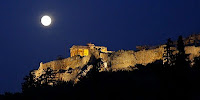Why Write? Paying Homage to Northern Lights aka Marry Your Dreams in 2012

Sometimes I miss a certain place, like the aspen draw on the ranch in Wyoming where Thimbleberries grow thick by July, and where snow gathers by October, staying until May. Sometimes I miss a person, like the young Greek girl Antigone whom I barely knew, but knew well enough to lie on a hill near the Acropolis, beneath the light of a full moon counting the stars as they came out. “ Ena Dio Tria Tessera,” she taught me, pointing at the sky. “One Two Three Four, ” I echoed back. Today, I am missing a magazine, and the vision that it brought to the world before publication ceased. Northern Lights , published by Deborah Clow O’Connor . "What does it mean to lose Northern Lights?" asked Charles Finn. "It is like asking what it means to lose a star from its place in the sky." WHY WRITE? asks The Center section of the Summer 1998 issue. The answers of seven writers were printed, including essays by Jane Hirschfield, Ellen Meloy, and C.L. ...








